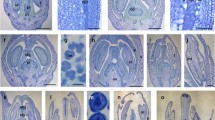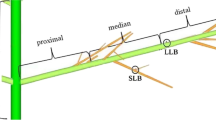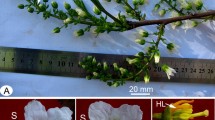Abstract
Key message
Low number of pistillate flowers in the tung tree is a major factor causing the low yield of tung fruits.
Abstract
The tung tree (Vernicia fordii Hemsl.), an economically important woody oil plant, produces excellent fast-drying oil from the seeds which has been used as a protective finish on projects and surfaces for centuries. Knowledge of sex determination and flower development of tung trees is helpful for high-yield cultivation and breeding of new elite cultivars. However, studies on tung flower biology and ontogeny are still lacking. Here, we reported a comprehensive study of the flower biology and ontogeny of the tung tree, focusing on flower cycle, flower morphology and flower development. The inflorescence phenophases of monoecious tung trees were divided into 12 pivotal stages and used as a unique timeline to reference the events registered throughout the flower cycle. Histological studies on sporogenesis and gametogenesis were also conducted. Meanwhile, all the unique events throughout flower cycle were linked together to show the correlation between inflorescence development phenophases, pistillate and staminate flower stages and its embryological development. Tung trees in our plantation were grouped into three major types, i.e., monoecious, gynoecious and androecious trees which produced different number of fruits in each inflorescence. We propose that low number of pistillate flowers in the tung tree is a major factor causing the low yield of tung fruits, and that any measures increasing the number of pistillate flowers would effectively improve the yield of tung fruits.









Similar content being viewed by others
References
Abbott CE (1929) Fruit-bud development in tire tung-oil tree. Agric Res 38:679–695
Adrian J, Torti S, Turck F (2009) From decision to commitment: the molecular memory of flowering. Mol Plant 4:628–642. https://doi.org/10.1093/mp/ssp031
Baillon H (1858) Etude Generale du Groupe des Euphorbiacees. Victor Masson, Paris
Berger F, Hamamura Y, Ingouff M, Higashiyama T (2008) Double fertilization—caught in the act. Trends Plant Sci 13:437–443. https://doi.org/10.1016/j.tplants.2008.05.011
Cao H, Shockey JM, Klasson KT, Mason CB, Scheffler BE (2013) Developmental regulation of diacylglycerol acyltransferase family gene expression in tung tree tissues. PLoS ONE 8:e76946. https://doi.org/10.1371/journal.pone.0076946
Chen M, Pan B, Wang G, Ni J, Niu L, Xu Z (2014) Analysis of the transcriptional responses in inflorescence buds of Jatropha curcas exposed to cytokinin treatment. BMC Plant Biol 14:318. https://doi.org/10.1186/s12870-014-0318-z
Chen J, Liu W, Fan Y, Zhou X, Tang X, Zhang L (2019) Identification and analysis of tRNA genes provide new insights into oil biosynthesis in tung tree (Vernicia fordii Hemsl.). Ind Crop Prod 137:71–80. https://doi.org/10.1016/j.indcrop.2019.05.016
Cui P, Lin Q, Fang D, Zhang L, Li R, Cheng J, Gao F, Shockey J, Hu S, Lu S (2018) Tung tree (Vernicia fordii Hemsl.) genome and transcriptome sequencing reveals co-ordinate up-regulation of fatty acid beta-oxidation and triacylglycerol biosynthesis pathways during eleostearic acid accumulation in seeds. Plant Cell Physiol 59:1990–2003. https://doi.org/10.1093/pcp/pcy117
D'Aloia M, Bonhomme D, Bouché F, Tamseddak K, Ormenese S, Torti S, Coupland G, Périlleux C (2011) Cytokinin promotes flowering of Arabidopsis via transcriptional activation of the FT paralogue TSF. Plant J 65:972–979. https://doi.org/10.1111/j.1365-313X.2011.04482.x
Dresselhaus T, Franklin-Tong N (2013) Male–female crosstalk during pollen germination tube growth and guidance and double fertilization. Mol Plant 6:1018–1036. https://doi.org/10.1093/mp/sst061
Falasca G, D’Angeli S, Biasi R, Fattorini L, Matteucci M, Canini A, Altamura MM (2013) Tapetum and middle layer control male fertility in Actinidia deliciosa. Ann Bot 112:1045–1055. https://doi.org/10.1093/aob/mct173
Fan X, Yuan D, Tang J, Tian X, Zhang L, Zou F, Tan X (2015) Sporogenesis and gametogenesis in Chinese chinquapin (Castanea henryi (Skam) Rehder & Wilson) and their systematic implications. Trees 29:1713–1723. https://doi.org/10.1007/s00468-015-1251-y
Feng Y, Man L, Hu Y, Chen L, Xie B, Zhang C, Yuan T, Yang Z (2019) One-pot synthesis of polyurethane-imides with tailored performance from castor and tung oil. Prog Org Coat 132:62–69. https://doi.org/10.1016/j.porgcoat.2019.03.035
Hill JP, Lord EM (1987) Dynamics of pollen tube growth in the wild radish Paphanus raphanistrum Brassicaceae. II. Morphology cytochemistry and ultrastructure of transmitting tissue and path of pollen tube growth. Am J Bot 74:988–997
Hrycan WC, Davis AR (2005) Comparative structure and pollen production of the stamens and pollinator-deceptive staminodes of Commelina coelestis and C. dianthifolia (Commelinaceae). Ann Bot 95:1113–1130. https://doi.org/10.1093/aob/mci134
Huang J, Yuan T, Yang Z, Man L, Hu Y, Yang Z (2019) UV/thermal dual curing of tung oil-based polymers induced by cationic photoinitiator. Prog Org Coat 126:8–17. https://doi.org/10.1016/j.porgcoat.2018.10.022
Huang Y, Pang L, Wang H, Zhong R, Zeng Z, Yang J (2013) Synthesis and properties of UV-curable tung oil based resins via modification of Diels–Alder reaction nonisocyanate polyurethane and acrylates. Prog Org Coat 76:654–661. https://doi.org/10.1016/j.porgcoat.2012.12.005
Jarillo JA, Pineiro M (2011) Timing is everything in plant development. The central role of floral repressors. Plant Sci 181:364–378. https://doi.org/10.1016/j.plantsci.2011.06.011
Johri BM, Ambegaokar KB, Srivastava PS (1992) Comparative embryology of angiosperms, vol 1. Springer, Berlin
Kinney M, Columbus J, Friar E (2008) Unisexual flower spikelet and inflorescence development in monoecious/dioecious Bouteloua dimorpha (Poaceae Chloridoideae). Am J Bot 95:123–132. https://doi.org/10.3732/ajb.95.2.123
Krohn N, Lausser A, Juranic M, Dresselhaus T (2012) Egg cell signaling by the secreted peptide ZmEAL1 controls antipodal cell fate. Dev Cell 23:219–225. https://doi.org/10.1016/j.devcel.2012.05.018
Li J, Pan B, Niu L, Chen M, Tang M, Xu Z (2018) Gibberellin inhibits floral initiation in the perennial woody plant Jatropha curcas. J Plant Growth Regul 37:999–1006. https://doi.org/10.1007/s00344-018-9797-8
Li N, Zhang D, Liu H, Yin C, Li X, Liang W, Yuan Z, Xu B, Chu H, Wang J, Wen T, Huang H, Luo D, Ma H, Zhang D (2006) The rice tapetum degeneration retardation gene is required for tapetum degradation and anther development. Plant Cell 18:2999–3014. https://doi.org/10.1105/tpc.106.044107
Liu C, Shang Q, Jia P, Dai Y, Zhou Y, Liu Z (2016) Tung oil-based unsaturated co-ester macromonomer for thermosetting polymers: Synergetic synthesis and copolymerization with styrene. ACS Sustain Chem Eng 4:3437–3449. https://doi.org/10.1021/acssuschemeng.6b00466
Liu M, Li W, Zhao G, Fan X, Long H, Fan Y, Shi M, Tan X, Zhang L (2019a) New insights of salicylic acid into stamen abortion of female flowers in tung tree (Vernicia fordii). Front Genet 10:316. https://doi.org/10.3389/fgene.2019.00316
Liu M, Long H, Li W, Shi M, Cao H, Zhang L, Tan X (2019b) Boosting C16 fatty acid biosynthesis of Escherichia coli yeast and tobacco by tung tree (Vernicia fordii Hemsl.) beta-hydroxyacyl-acyl carrier protein dehydratase gene. Ind Crop Prod 127:46–54. https://doi.org/10.1016/j.indcrop.2018.10.067
Lizarazu MA, Pozner RE (2014) Nucellar beak structure and pollen tube growth in Cucurbitaceae. Flora Morphol Distrib Funct Ecol Plants 209:340–348. https://doi.org/10.1016/j.flora.2014.04.003
Man L, Hu Y, Feng Y, Zhang C, Yuan T, Yang Z (2019) Facile synthesis of a novel bio-based methacrylate monomer derived from tung oil and its application for solvent-free thermosetting coatings. Ind Crop Prod 133:348–356. https://doi.org/10.1016/j.indcrop.2019.03.047
Mao Y, Hou J, Chen X, Ni J, Zhao W, Wu L (2017a) Identification of potential molecular markers for flower sex determination in Vernicia fordii. J Hortic Sci Biotech 93:264–271. https://doi.org/10.1080/14620316.2017.1362963
Mao Y, Liu W, Chen X, Xu Y, Lu W, Hou J, Ni J, Wang Y, Wu L (2017b) Flower development and sex determination between male and female flowers in Vernicia fordii. Front Plant Sci 8:1291. https://doi.org/10.3389/fpls.2017.01291
McCann LP (1942) Development of the pistillate flower and structure of the fruit of tung. J Agric Res 65:361–378
Mitchell CH, Diggle PK (2005) The evolution of unisexual flowers: morphological and functional convergence results from diverse develomental transition. Am J Bot 91:1068–1076. https://doi.org/10.3732/ajb.92.7.1068
Park JY, Kim DK, Wang Z, Lu P, Park SC, Lee JS (2008) Production and characterization of biodiesel from tung oil. Appl Biochem Biotechnol 148:109–117. https://doi.org/10.1007/s12010-007-8082-2
Perera PI, Quintero M, Dedicova B, Kularatne JD, Ceballos H (2013) Comparative morphology biology and histology of reproductive development in three lines of Manihot esculenta Crantz Euphorbiaceae: Crotonoideae. AoB Plants 5:pls046. https://doi.org/10.1093/aobpla/pls046
Shockey J, Rinehart T, Chen Y, Wang Y, Zhan Z, Hu L (2016) Tung (Vernicia fordii and Vernicia montana). In: Industrial oil crops. AOCS Press, pp 243–273.https://doi.org/10.1016/B978-1-893997-98-1.00010-5
Tian X, Yu Q, Liu H, Liao J (2016) Temporal-spatial transcriptome analyses provide insights into the development of petaloid androecium in Canna indica. Front Plant Sci 7:1194. https://doi.org/10.3389/fpls.2016.01194
Tekleyohans DG, Nakel T, Groß-Hardt R (2017) Patterning the female gametophyte of flowering plants. Plant Physiol 173:122–129. https://doi.org/10.1104/pp.16.01472
Tilton VR (1980) The nucellar epidermis and micropyle of Ortlithognlrrttl caudntrrtn Liliaceae with a review of these structures in other taxa. Can J Bot 58:1872–1884
Walker-Larsen J, Harder LD (2000) The evolution of staminodes in angiosperms: patterns of stamen reduction loss and functional re-invention. Am J Bot 87:1367–1384. https://doi.org/10.2307/2656866
Wellmer F, Riechmann LJ (2010) Gene networks controlling the initiation of flower development. Trends Genet 26:519–527. https://doi.org/10.1016/j.tig.2010.09.001
Werner T, Schmulling T (2009) Cytokinin action in plant development. Curr Opin Plant Biol 12:527–538. https://doi.org/10.1016/j.pbi.2009.07.002
Xu W, Yang Q, Huai H, Liu A (2011) Microsatellite marker development in tung trees Vernicia montana and V. fordii. Euphorbiaceae Am J Bot 98:e226–e228. https://doi.org/10.3732/ajb.1100151
Yadegari R, Drews NG (2004) Female gametophyte development. Plant Cell 16:S133–S141. https://doi.org/10.1105/tpc.018192
Yang W, Ye D, Xu J, Sundaresan V (1999) The SPOROCYTELESS gene of Arabidopsis is required for initiation of sporogenesis and encodes a novel nuclear protein. Gene Dev 13:2108–2117. https://doi.org/10.1101/gad.13.16.2108
Zhan Z, Chen Y, Shockey J, Han X, Wang Y (2016) Proteomic analysis of tung tree (Vernicia fordii) oilseeds during the developmental stages. Molecules 21:1486. https://doi.org/10.3390/molecules21111486
Zhan Z, Wang Y, Shockey J, Chen Y, Zhou Z, Yao X, Ren H (2012) Breeding status of tung tree Vernicia sp. in China a multipurpose oilseed crop with industrial uses. Silvae Genet 61:265–270. https://doi.org/10.1515/sg-2012-0033
Zhang L, Jia B, Tan X, Thammina CS, Long H, Liu M, Wen S, Song X, Cao H (2014) Fatty acid profile and unigene-derived simple sequence repeat markers in tung tree (Vernicia fordii). PLoS ONE 9:e105298. https://doi.org/10.1371/journal.pone.0105298
Zhang L, Liu M, Long H et al (2019) The tung tree (Vernicia Fordii) genome provides a resource for understanding genome evolution and oil improvement. Genom Proteom Bioinform 17:558–575. https://doi.org/10.1016/j.gpb.2019.03.006
Zhang L, Wu P, Lu W, Lu S (2018) Molecular mechanism of the extended oil accumulation phase contributing to the high seed oil content for the genotype of tung tree (Vernicia fordii). BMC Plant Biol 18:248. https://doi.org/10.1186/s12870-018-1458-3
Zhou C, Hu Y, Li P, Yuan T, Huang J, Li P, Liu Y, Zhang S, Yang Z (2018) Facile synthesis and characterization of urushiol analogues from tung oil via ultraviolet photocatalysis. Prog Org Coat 120:240–251. https://doi.org/10.1016/j.porgcoat.2018.03.015
Acknowledgements
The study was supported by the National Natural Science Foundation of China (Project No. 31770720), the National Key R&D Program of China (Project No. 2017YFD0600703), the Postgraduate Scientific Research. Innovation Project of Hunan Province (Project Nos. CX20200696 and CX2018B444) and the Scientific Innovation Fund for Graduate of Central South University of Forestry and Technology (Project Nos. CX20201003 and 20183005).
Author information
Authors and Affiliations
Contributions
LZ and WL contributed to the conception and design of the study. Field and lab experiments, plant materials collection, and data analysis was performed by WL, ML, XD, YW, and LZ. The first draft of the manuscript was written by LZ and WL. HC gave some useful comments and revised the manuscript. HS and HH managed the tung orchard and participated in phenological observation of tung flowers and plant material collection. All authors read and commented on the manuscript.
Corresponding author
Ethics declarations
Conflict of interest
The authors declare that they have no conflict of interest.
Additional information
Communicated by Kalcsits.
Publisher's Note
Springer Nature remains neutral with regard to jurisdictional claims in published maps and institutional affiliations.
Rights and permissions
About this article
Cite this article
Li, W., Liu, M., Dong, X. et al. Flower biology and ontogeny of the tung tree (Vernicia fordii Hemsl.). Trees 34, 1363–1381 (2020). https://doi.org/10.1007/s00468-020-02041-3
Received:
Accepted:
Published:
Issue Date:
DOI: https://doi.org/10.1007/s00468-020-02041-3




